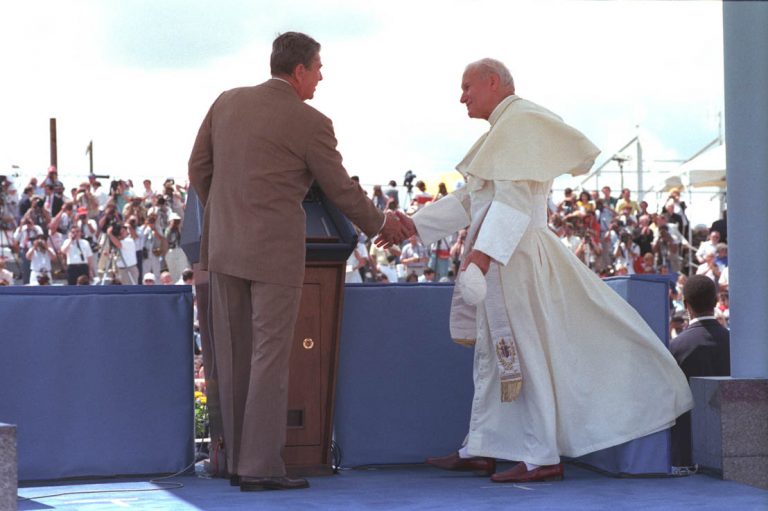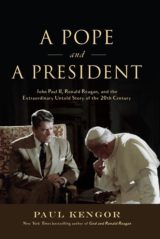
In 1939, the Nazi German forces invaded Poland. Among the many other changes following occupation, the Nazis closed all Polish universities, sending university students into an array of forced labor positions.
One of these university students was Karol Józef Wojtyła, the future Pope John Paul II. He would spend the rest of his youth and much of his life fighting Soviet Communism.
Pope John Paul II is credited with helping to end Communism in Poland, and eventually all of Europe. He wasn’t just the man who happened to be pope during the height of Communism—he was a pope uniquely suited to answering its threat. As a young man, he experienced the Communist regime’s opposition to human dignity first-hand. This not only shaped his own life--it shaped the Catholic Church, and ultimately the world.
Through his incredible work defending human dignity, John Paul II’s papacy directly opposed the Communist restriction of freedom. In this, John Paul II found an ally in the United States.
The story of John Paul II and Ronald Reagan is that of two profoundly influential men whose common goal united them across the secular and religious divide of the twentieth century.
Although historians credit John Paul II and Reagan with helping to end the Cold War, many have missed the significance of the close bond that formed between them. The Catholic pope and Protestant president shared a singular bond that drove them to fight Soviet Communism and its crushing repression of human freedom.
In his groundbreaking work A Pope and a President: John Paul II, Ronald Reagan, and the Extraordinary Untold Story of the 20th Century, Paul Kengor notes that the two leaders were not only united against Communism, but they were united for essential rights and liberties: among these, faith, freedom, and the sanctity of life.
To Reagan—and to John Paul II—genuine freedom was not mere license. Freedom carried responsibilities rooted in faith. This is the Christian conception of freedom. . . . Without the rock and rudder of faith, John Paul II said, freedom can become confused, perverse, and can even lead to the destruction of freedom for others.
Closely connected to their common view of freedom was the cause of that freedom.
Like John Paul II, Reagan believed that the right to life is the first and most fundamental of all human freedoms, without which other human freedoms cannot exist. . . .This core conviction about the inherent dignity of human life, more than any other, led both John Paul II and Reagan to oppose international communism so passionately. They did not (as so many dupes during the Cold War did) see the Soviet Union as a different but still ‘legitimate’ political entity; they viewed atheistic Soviet Communism as a monstrosity, primarily because it trampled on the first and most fundamental of all human rights. No other system was such an affront to the beliefs they held sacred. It was evil, and they would not shy away from calling it such.
Both John Paul II and Reagan are recognized individually for their tremendous service to current human rights, especially in their work upholding the sanctity of life. But as the subtitle of Kengor’s book suggests, the partnership of these two leaders might be the great untold story of the last century. In A Pope and a President, uncover this incredible story and the two men who changed history.
Read the Book

In A Pope and a President: John Paul II, Ronald Reagan, and the Extraordinary Untold Story of the 20th Century, acclaimed scholar and bestselling author Paul Kengor tells the story of the partnership between Pope John Paul II and President Ronald Reagan and how together they changed the course of world history.